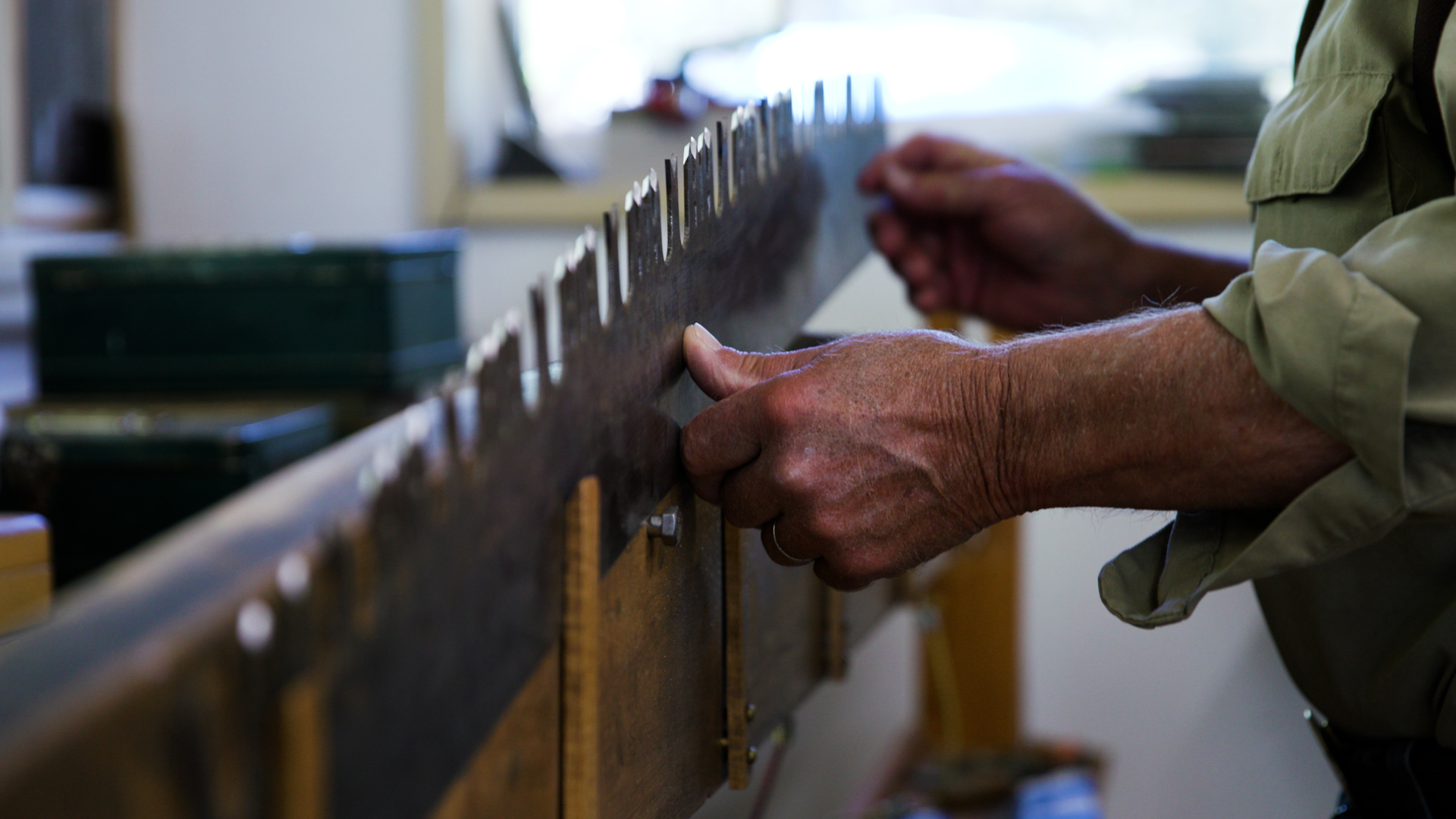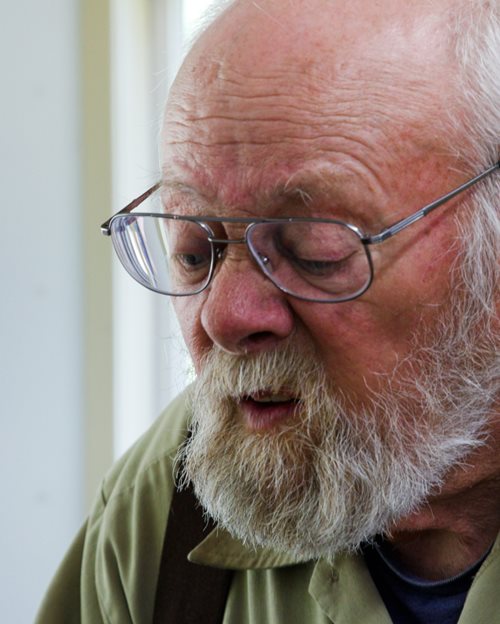Even the wilderness needs a little grooming help from time to time…
Protecting the Montana wilderness is a big job, and it comes full circle.
Take the Bob Marshall Wilderness Complex, for example. That’s over 1.5 million acres of breathtaking rugged wilderness, all in Montana. It’s protected by the efforts and legislation of Montanans, many of whom work or volunteer to help clear and maintain its trail system. Those tools require maintenance, and that’s where cross-saw craftsman Fred Flint comes in. In turn, he files and repairs the large two-person saw that usually requires two people to use. That keeps the trails clear so they can be accessed by travelers, outdoors folks, horses, and everyone who finds peace and solace in the stunning expanse of the Bob.
Fred does his part. But what most folks don’t know is that Fred Flint and his highly skilled trade are rare…and becoming more rare still as the times march forward and the highly specialized art of filing and maintaining cross-cut saws begins to die out.
Like any master craftsman, Fred embodies a wealth of knowledge about cross-cut saws that inspire others to seek mastery in their own crafts. Having served in the US Forest Service at Hungry Horse and Spotted Bear, he’s done his time in the wilderness. And what he does know about his craft shines in his voice, the awe of someone who works with—and wholly respects—the deceptively simple engineering of a cross-cut saw as he assesses its sharp, jagged, and meticulously-honed teeth.

"Well, they call them primitive tools, but they’re not...”
“Well, they call them primitive tools, but they’re not,” he says from his shop in Columbia Falls, Montana. “They’re pretty sophisticated. I mean, this is 1800s stuff. Thinnest in the center, thicker on the ends. Now, how did they do that before laser technology? I don’t know.”
While some saws are manufactured, the most treasured by those who use them are the vintage saws, many of which were crafted in the nineteenth century by highly skilled craftsmen who understood not only the nature of the metal and what it needed to do but had uncanny insight into how to cut into wood across the grain in the most efficient manner possible. These older saws are sought after for their strength, flexibility, and even their smoothness.

No extra resources are needed. No electrical or mechanical failures. No gas, no power. In the world of saws, the vintage cross-cut saw is like a Great White shark—so perfectly engineered to do its job that it doesn’t need to evolve. Mass manufacturing can’t duplicate the quality and crafting tools that can last not just generations but centuries…well, it’s an art that’s mostly dead.
“Nobody’s making these anymore. Yunno, there just isn’t the demand. If everyone needed a cross-cut saw, well, then Elon Musk’d be makin’ them,” Fred laughs. Behind his glasses, his blue eyes are lively, belying his older years.
“After the Second World War, a one-man chainsaw weighed 125 pounds. Then they got better and better, and almost overnight, cross-cuts went away…They just can’t compete on a commercial basis. So in that—since they’re dying—it was too efficient to use the gas-powered saws,” he says, shrugging.
But the Bob Marshall still uses them. Why is that?
“Because it’s wilderness,” comes the blunt, no-frills response. “If you’re clearing trails, then you use the chainsaw. You carry in the gas, chaps, face protection, ear protection. This one”—he gestures to the cross-cut saw—"you put a sheath on it, put it over your shoulder, and walk.”
But the cross-cut saw isn’t just easier for transportation.
The Wilderness Act of 1964 prohibits the use of motorized equipment and tools in protected wilderness areas, including motor vehicles and motorized equipment. Nothing on wheels. Nothing that has an engine, including boats, trucks, cars, or…you guessed it, chainsaws. This legislation is a part of the National Wilderness Preservation System. Allowing motorized and gas-powered machines would compromise not only the values of the protective system but would change the very nature of the wilderness and the efforts made to preserve it.
The wilderness must remain a wilderness—especially when we’re tempted to tame it.
“Forest Service standard is to use those kind of tools back there,” says Fred. “And the cross-cut saws are the one tool in their inventory that they can’t easily maintain themselves.”

And so, tucked away in Columbia Falls, is Fred’s shop. A hand-painted saw reading “The File Shack” hangs over the door. Here, Fred keeps saws ready for trail crews across Northwest Montana, including the Back Country Horsemen and Bob Marshall Wilderness Foundation Trail Crew. Inside is orderly and spacious—cross-cut saws can start at around four feet long and go up to as long as even twelve feet or more. The last thing anyone needs is an accident.
“If you ask me who else files like I do, I couldn’t tell ya,” says Fred

Of course, few people know that these intimidatingly vicious-looking saws are designed for safety. The more distance there is between the cutter and the wood, the more protected they’ll be. And in the shop, the saws are managed by Fred’s skilled, oh-so-capable hands.
But it’s a dying art. In a world dominated by disposable products and mass manufacturing facilities, there are few who will take the time and effort to work on something by hand, to sharpen dull edges, or fix a nearly unnoticeable flaw like a broken tooth. There’s value in these old tools and in how they can be lovingly maintained for a lifetime or three. But there’s little profit in it.
“If you ask me who else files like I do, I couldn’t tell ya,” says Fred. “I don’t know anyone else that’s doing it. Someday, maybe there won’t be any saws left. Who knows? But you know, they’re there. ‘We found this one in Grandpa’s barn when we cleaned out the place,’” he laughs. “I mean, somebody’s gotta tell them how it was.”
So Fred continues—in his own humble but no less impactful way—to maintain his part of the circle that supports and maintains the wilderness. Much like the cross-cut saws, it’s part of an arc.
And without him, that circle would be broken.
For members like you.
Because what we do pays dividends.
